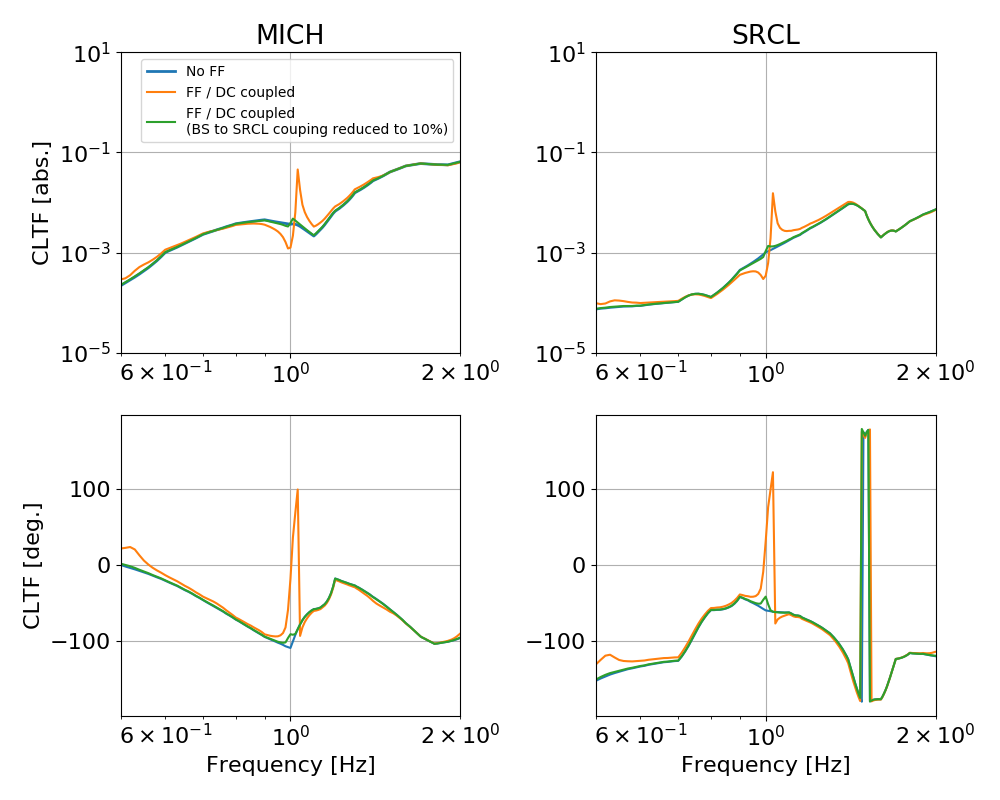I made a rough but representative model of why the SRCL feed-forward causes instabilities. The model works quite well in predicting an instability at about 1 Hz when the SRCL feed-forward is engaged and DC-coupled.
The model is based on:
- only MICH and SRCL longitudinal loops are modeled
- measurement of the optical response of the MICH and SRCL error signals, as measured in 44941. To keep things simple I treated the error signal response as frequency independent and I included only diagonal terms
- the suspension response is taken from the QUAD model plus G1100968 and from 44941
- I assumed the geometrical coupling from MICH to SRCL due to the fact that we are actuating MICH only on BS, and thus creating a significant SRCL motion
- the control filters are taken from the real time model
- the SRCL feed-forward is taken to be zero (no feed-forward), or as a constant (DC-coupled), or a constant times an high pass at 10 Hz (AC-coupled)
With the feed-forward off, the model reproduces well the open loop transfer functions. The key thing to consider here are however the closed-loop responses of the two coupled loops. The plot below shows three traces: in blue (hidden by the green trace) the case without feed-forward, which is known to be stable (as confirmed by the open loop gain); in orange the case with the SRCL feed-forward on, but without the high pass: this trace shows a "wiggle" around 1 Hz; in green the case with feed-forward on and high pass at 10 Hz (this trace hides the blue trace).
So the model explains quite well that adding the current 10Hz high pass remove any perturbation to the closed loop gain at 1 Hz. Morevoer, we can take the ratio [closed loop gain with DC-coupled feed-forward] / [closed loop gain without DC-coupled feed-forward] and fit it. The fit contains indeed an unstable pole at about 1.03 Hz. So the model explains how the interaction of the SRCL feed-forward with the SRCL and MICH loop creates an instability.
Finally, if we reduce the geometrical coupling of BS to SRCL to 10% of the value we get by actuating only on the BS (in other words if we send the MICH control to SRM or SR2 or SR3 and cancel 90% of the coupling), the model predicts that the 1 Hz instability is gone, see the plot below for a zoom of the closed loop transfer function around 1 Hz. Blue trace: stable, no SRCL FF; orange unstable, just with DC couple FF and MICH driving to BS only; green stable, with DC coupled SRCL FF and MICH driving to both BS and SRC, with a precision of 10%.
So the model gives us two ways (at least) to fix this instability, by reducing the MICH / SRCL cross coupling:
- send the MICH control to BS and to SRM / SR2 or SR3 (whichever is practical)
- send the SRCL feed-forward to the ETMs, since this should largely reduce the direct coupling of SRCLFF output to MICH, and thus cut the spurious loop in a different place



